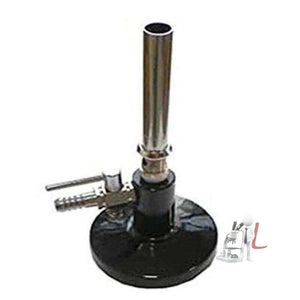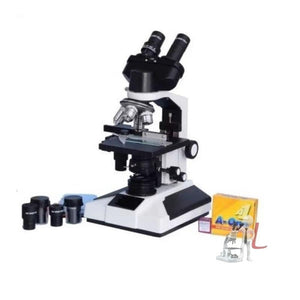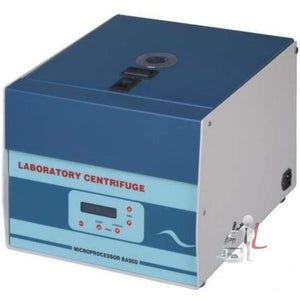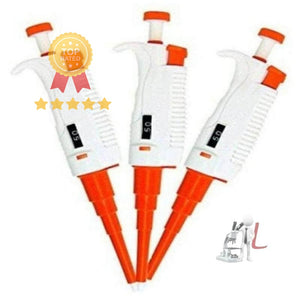Laboratory Equipment Uses and Their Importance in Scientific Research

Laboratory Equipment Uses
Laboratory equipment uses are essential in the realm of scientific research, playing a pivotal role in the discovery and development of new technologies and theories. The advancements in research methodologies over the years have led to the evolution of laboratory equipment, enabling scientists to conduct experiments with precision and accuracy. From basic tools like pipettes and beakers to sophisticated instruments such as spectrophotometers and chromatographs, the variety of equipment available supports a wide range of scientific investigations.
When it comes to scientific research and experimentation, having the right lab equipment is crucial. Each piece of equipment serves a specific purpose and plays a vital role in the success of experiments. In this blog post, we will delve into the world of lab equipment and explore their uses.
What is a Bunsen Burner and How is it Used?

A Bunsen burner is a staple in any laboratory. It is a gas burner used for heating, sterilizing, and combustion purposes. By adjusting the air and gas flow, scientists can control the intensity of the flame. Bunsen burners are commonly used in experiments that require heating substances or sterilizing equipment.
How Does a Microscope Work and What Can it Reveal?

A microscope is an essential tool for magnifying and observing tiny objects that are otherwise invisible to the naked eye. It works by using lenses to bend light and create an enlarged image. Microscopes are used in various scientific fields, such as biology and chemistry, to study cells, microorganisms, and other minute structures.
What is the Purpose of a Centrifuge in a Laboratory?

A centrifuge is a device used to separate substances of different densities by spinning them at high speeds. It utilizes centrifugal force to separate components such as liquids and solids. Centrifuges are commonly used in medical laboratories to separate blood components, in chemistry labs for purification purposes, and in research facilities for various scientific studies.
How Does a Spectrophotometer Measure Light?

A spectrophotometer is an instrument used to measure the intensity of light at different wavelengths. It works by passing light through a sample and measuring the amount of light absorbed or transmitted. Spectrophotometers are widely used in chemistry and biology to analyze the concentration of substances, identify unknown compounds, and study the interaction of light with matter.
What is the Role of a Fume Hood in Laboratory Safety?

A fume hood is a ventilated enclosure used to safely handle hazardous or toxic substances. It works by drawing air away from the user and expelling it outside the laboratory, preventing the inhalation of harmful fumes. Fume hoods are essential for maintaining a safe working environment in laboratories where volatile chemicals or gases are used.
Why are Pipettes Essential Tools in a Laboratory?

Pipettes are precision instruments used to measure and transfer small volumes of liquid. They come in various forms, such as micropipettes and serological pipettes, and are used in a wide range of scientific applications. Pipettes are crucial for accurately dispensing reagents, preparing samples, and conducting experiments that require precise liquid handling.
These are just a few examples of the many lab equipment and their uses. Each piece of equipment serves a specific purpose and contributes to the advancement of scientific knowledge. By understanding the functions and applications of these tools, scientists can conduct experiments with precision and accuracy, leading to groundbreaking discoveries.
What is laboratory equipment?
Laboratory equipment refers to the various tools and instruments used in scientific research, experimentation, and analysis. These tools are designed to assist scientists, researchers, and technicians in conducting experiments, measuring and analyzing data, and performing various scientific procedures.
Why is laboratory equipment important?
Laboratory equipment plays a crucial role in scientific research and discovery. It enables scientists to gather accurate data, perform precise measurements, and conduct experiments under controlled conditions. Without proper laboratory equipment, it would be challenging to carry out scientific investigations and make scientific advancements.
Common laboratory equipment and their uses
1. Microscope: A microscope is used to magnify small objects or organisms that are not visible to the naked eye. It is widely used in biology, medicine, and other scientific fields to study cells, microorganisms, and tissues.
2. Bunsen burner: A Bunsen burner is a gas burner used for heating, sterilizing, and combustion in the laboratory. It is commonly used in chemistry experiments and various laboratory procedures.
3. Beaker: A beaker is a cylindrical container with a flat bottom and a pouring lip. It is used for mixing, heating, and measuring liquids in the laboratory.
4. Pipette: A pipette is a laboratory tool used to transfer small amounts of liquid accurately. It is commonly used in chemistry, biology, and medical laboratories.
5. Centrifuge: A centrifuge is a machine used to separate substances of different densities using centrifugal force. It is widely used in biology, chemistry, and medical laboratories for separating liquids and solids.
6. pH meter: A pH meter is used to measure the acidity or alkalinity of a solution. It is an essential tool in chemistry, biology, and environmental science.
7. Incubator: An incubator is a device used to provide controlled conditions for the growth and development of organisms or cells. It is commonly used in microbiology and cell culture laboratories.
8. Spectrophotometer: A spectrophotometer is an instrument used to measure the intensity of light absorbed or transmitted by a sample. It is widely used in chemistry, biochemistry, and molecular biology for quantitative analysis.
Conclusion
Laboratory equipment is vital for scientific research and experimentation. It enables scientists to conduct accurate measurements, perform experiments, and analyze data. The wide range of laboratory equipment available serves various purposes and plays a crucial role in advancing scientific knowledge and understanding.
One of the primary categories of laboratory equipment is measuring instruments. These tools allow researchers to quantify variables accurately and consistently. For example, analytical balances measure mass with extreme precision, ensuring that experimental outcomes are reliable. In physics laboratories, equipment such as oscilloscopes helps visualize electrical signals, whereas thermometers and pressure gauges provide critical data in chemistry and biology experiments.
Another significant area is the use of glassware, which includes flasks, beakers, and test tubes. These items are fundamental in chemical reactions, as they allow for the safe mixing of substances. Additionally, glassware is often designed to withstand extreme temperatures and pressures, making it indispensable in many laboratory settings. Researchers also utilize specialized glassware, like volumetric flasks, for preparing solutions to precise concentrations, reflecting the importance of laboratory equipment uses in achieving accurate results.
Heating devices also play an important role in the lab. Bunsen burners, hot plates, and incubators provide controlled heating, which is crucial for many chemical reactions, biological cultures, and material testing. The ability to apply heat uniformly and at specific temperatures can significantly impact the outcome of an experiment, further highlighting the relevance of laboratory equipment in scientific research.
Moreover, the realm of biochemistry and molecular biology has seen the emergence of advanced laboratory equipment like centrifuges and PCR machines. Centrifuges separate components in a mixture based on density, crucial for purifying proteins or cellular organelles. PCR machines, on the other hand, amplify DNA sequences, enabling studies in genetics, forensics, and medical diagnostics. Thus, these sophisticated instruments exemplify the diverse laboratory equipment uses that facilitate groundbreaking research.
Safety equipment is another critical area of laboratory equipment. Fume hoods, safety goggles, and gloves protect researchers from hazardous substances, ensuring a safe working environment. The selection and proper use of safety equipment are paramount in preventing accidents and ensuring compliance with health regulations. This aspect underscores the dual importance of laboratory equipment in not only conducting research but also safeguarding the well-being of scientists.
Finally, data management and analysis equipment play an increasingly critical role in modern laboratories. Computers, software, and specialized analytical instruments allow researchers to collect, analyze, and interpret vast amounts of data generated during experiments. Bioinformatics tools, for example, assist in genomics research by analyzing genetic data, leading to discoveries that can revolutionize medicine and agriculture. These integrations showcase how laboratory equipment uses have become more complex and interconnected in the age of digital research.
In summary, the wide array of laboratory equipment utilizes are fundamental to scientific research across various disciplines. From measuring and mixing to safety and data analysis, each type of equipment serves a unique purpose, contributing to the integrity and success of research initiatives. Understanding the importance of laboratory equipment and its uses will enable researchers to maximize their potential and drive innovation in their respective fields.
Top Suppliers
Collections
- Dairy products
- Milk Testing Equipment
- physics lab
- Laboratory And Scientific Equi...
- microscopes
- ENT AND OPHTHALMIC
- measuring tools
- Centrifuge machine
- Micrometer
- Micropipette
- Silica Gel
- BOTANY PERMANENT MICRO-PREPARE...
- PERMANENT SLIDES
- centrifuge machine
- mask - type of mask
- medical products
- bod incubator
- Lab Chemical
- Do meter
- Lab Fabric items
- dental Autoclave
- medical mannequin
- White PVC Plastic Human Skelet...
- Human Body Part Models
- Heart Models
- Knee Joint Model
- Skull Models
- Laboratory Centrifuge
- Handi Centrifuges
- Microcentrifuge
- Table Top Centrifuge
- Digital Centrifuge Machine
- Pusher Centrifuge
- Laboratory Consumables
- Melting Point Apparatus
- Soxhlet Extraction Apparatus
- Distilling Apparatus
- Chemistry Lab Apparatus
- Chromatography Apparatus
- Diffusion Cell Apparatus
- Flash Point Apparatus
- Science Laboratory Equipment
- Profile Projectors
- Engineering Laboratory Equipme...
- Types of Microscopes
- General Laboratory Equipment
- Heating & Cooling Products
- Hospital equipment
- Testing Equipment
- Clean Air Equipment
- Engineering & Institute labora...
- HEAT & MASS TRANSFER LAB
- REFRIGERATION & AIR CONDITIONI...
- I.C. ENGINE LAB
- FLUID MECHANICS AND MACHINERY ...
- STRENGTH OF MATERIALS LAB
- EDM LAB equipment
- MATERIAL SCIENCE LAB
- FMS LAB
- CAD LAB
- AUTOMOBILE LAB
- MEASUREMENT & METROLOGY LAB
- DYNAMICS OF MACHINES LAB
- CENTRAL WORKSHOP
- Aerospace Engineering lab Equi...
- Biological Sciences lab Equipm...
- Chemical Engineering Equipment
- Civil Engineering
- Mechanical Engineering
- School And College University ...
- Lab Glassware & Chemical Items
- Zoology Lab Equipment
- Microbiology laboratory equipm...
- Chemistry Lab Products
- Botany Lab Product
- Biological Lab Equipment
- Department Of Anatomy Lab Equi...
- College of Nursing Lab Equipme...
- Endocrinology, Metabolism & Di...
- Haematology Lab Equipment
- Orthopaedics lab equipment
- Pediatric lab equipment
- Pathology lab equipment
- Physiology lab equipment
- Rheumatology lab equipment
- Urology lab equipment
- Obstetrics and Gynaecology lab...
- Otorhinolaryngology lab equipm...
- Pharmacology lab equipment
- Anatomy lab equipment
- Research Section lab equipment
- Pharmaceutical & Research Lab ...
- Physical Pharmacy Lab equipmen...
- Pharma Biology Laboratory Lab ...
- General Laboratory Equipment
- School And College University ...
- Medical College Lab equipment
- Biomedical Engineering Lab Equ...
- Biostatistics Lab Equipment
- Cardiology Lab Equipment
- College of Nursing Lab Equipme...
- Gastroenterology and Human Nut...
- Gastroenterology and Human Nut...
- Nursing Department lab equipme...
- Paediatrics lab equipment
- Reproductive Biology lab equip...
- Rheumatology lab equipment
- Biochemistry lab equipment
- Biophysics lab equipment
- Biotechnology lab equipment
- Centre for Community Medicine ...
- Nephrology lab equipment
- Pharmaceutical Chemistry Lab E...
- Microbiology & Pharmacology La...
- D Pharmacy equipment
- B pharmacy Equipments
- Pharmaceutics Laboratory Equip...
- Pharma Analysis Laboratory Equ...
- Animal House lab Equipment
- Pharmacognosy Laboratory Equip...
- Pharmacy laboratories equipmen...
- DEPARTMENT OF PHARMACOLOGY Equ...
- DEPARTMENT OF PHARMACOGNOSY Eq...
- DEPARTMENT OF P'CEUTICAL CHEMI...
- DEPARTMENT OF P'CEUTICS Equipm...
- PHARMACEUTICAL BIOTECHNOLOGY E...
- Livestock & Production Managem...
- Veterinary Sciences Lab Produc...
- Live Stock & Production Manage...
- Genetics and Plant Breeding la...
- Biotechnology lab equipment
- Seed Technology Lab Equipment
- Genetics and Plant Breeding la...
- Biotechnology
- Seed Technology
- Soil Science & Soil Water Cons...
- Entomology Lab equipment
- Agronomy Lab Equipment
- Metrological Lab Equipment
- Plant Pathology & Microbiology...
- Dental Equipment
- Microbiological Diagnostic Equ...
- Industrial & Soil Equipment
- Accessories
- Mega Offer
- Offer Zone
- Tiles Ceramic Laboratory Equip...
- analytical lab Equipment
- ayurvedic drug testing laborat...
- ayurvedic pharmacy instruments
- herbal testing laboratory
- mushroom lab Equipment
- lab plasticware
- agriculture Lab Equipment
- Agriculture College Lab Equipm...
- Labpro Banner 60%
- Labpro banner
- physics 60% Discount
- Hospital equipment supplier Ne...
Top Suppliers
Blog Posts
- green laser Light...
- Student Stereo Mi...
- Binocular Microsc...
- Laboratory Equipm...
- Prokaryos lab and...
- Pharmacy Lab
- Micro lab Laminar...
- MILK TESTING EQUI...
- Micrometer
- Centrifuge Machin...
- Chemistry Lab Equ...
- Agricultural coll...
- full body sanitiz...
- hydrometer for wi...
- Portable Bottle f...
- Egg Incubator
- Laboratorydeal of...
- A complete list o...
- different types o...
- Uses of Microscop...
